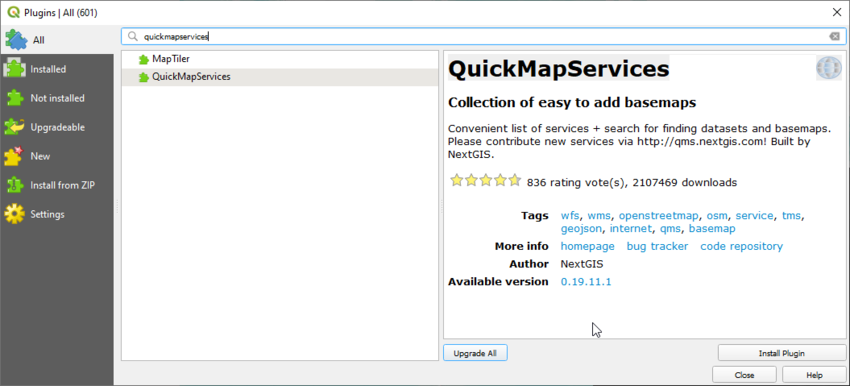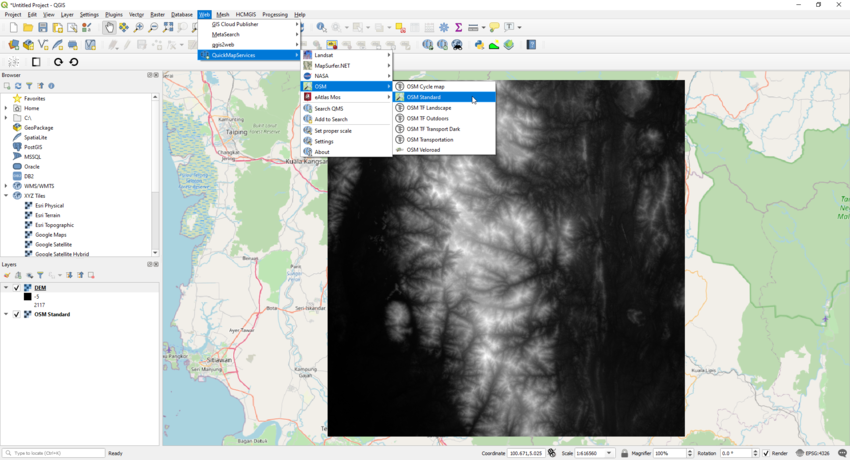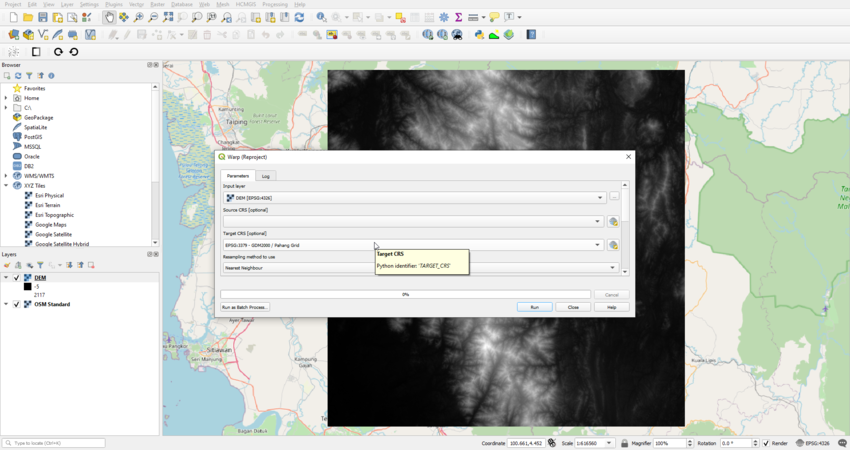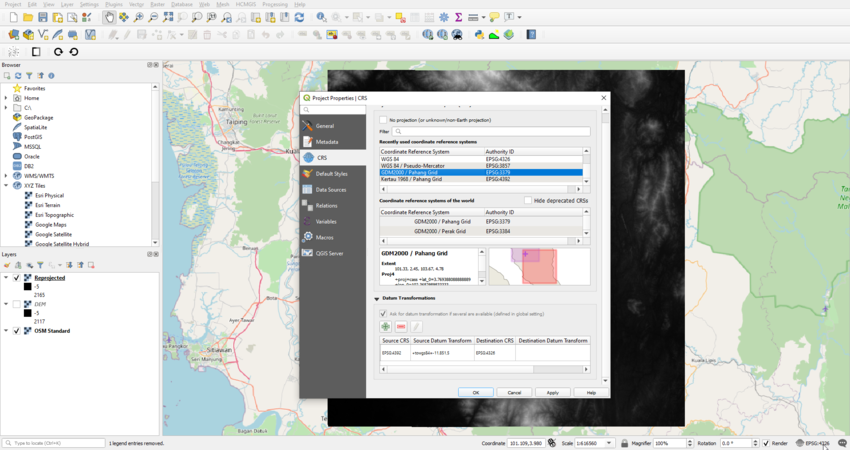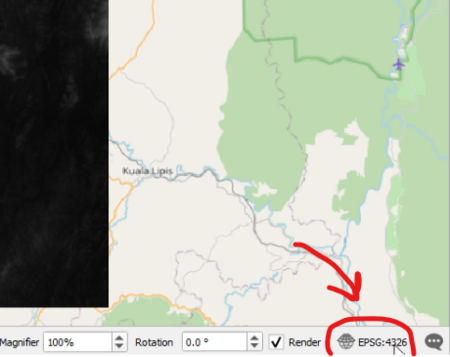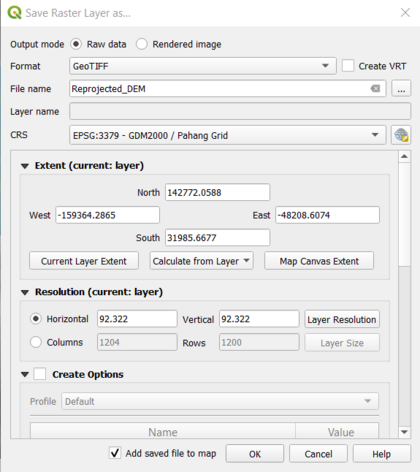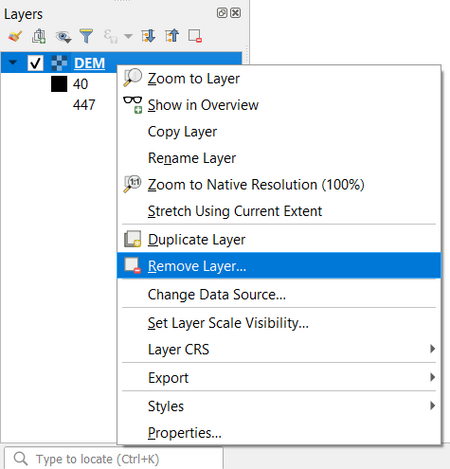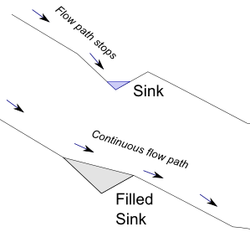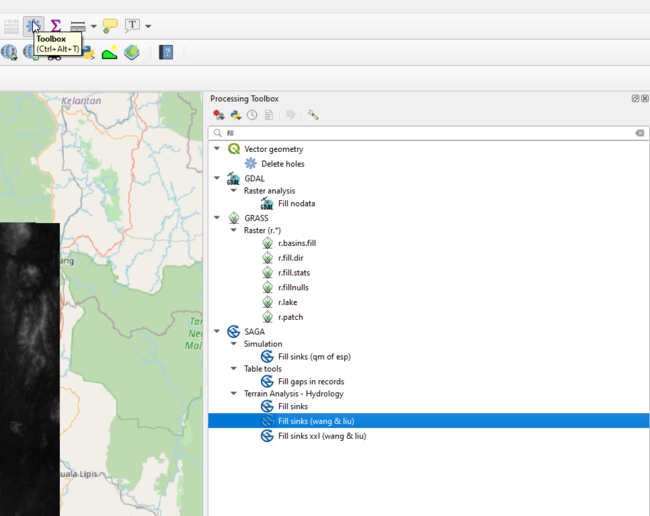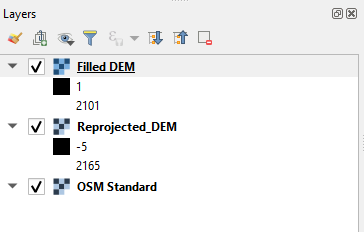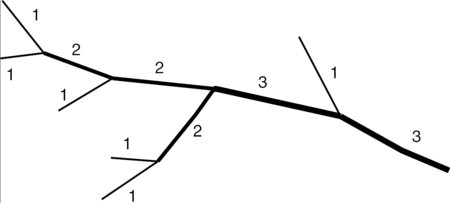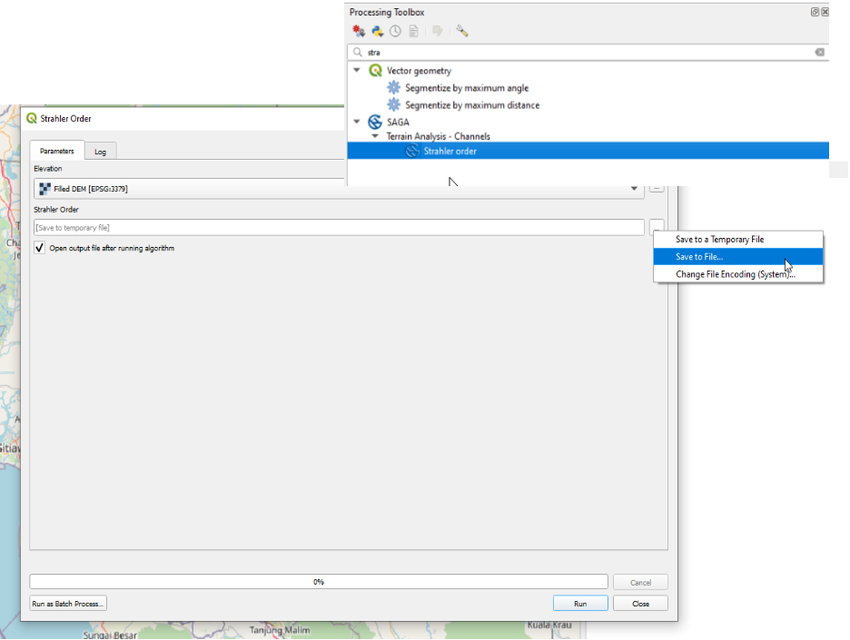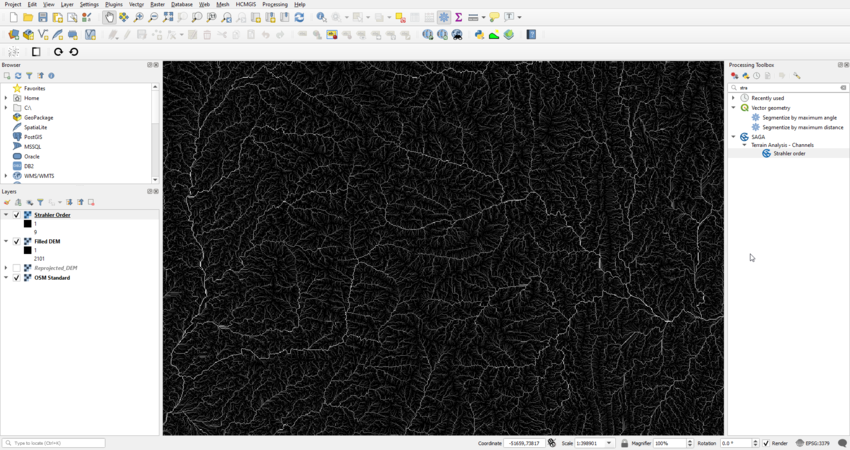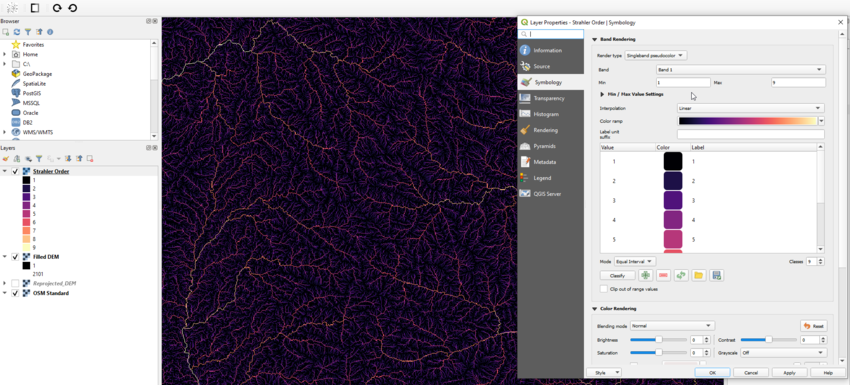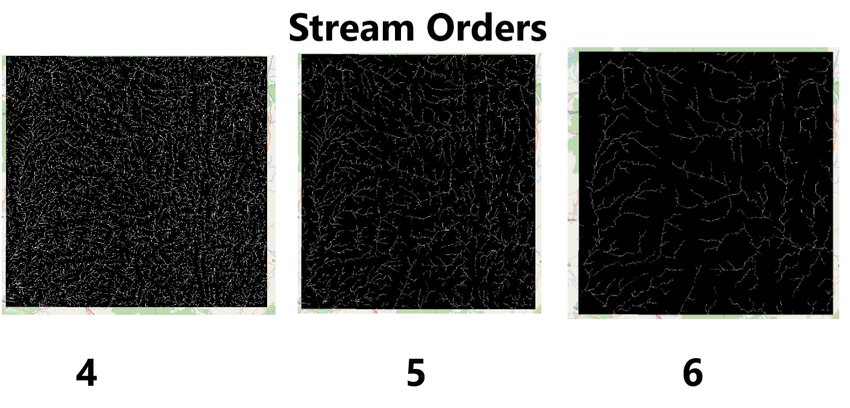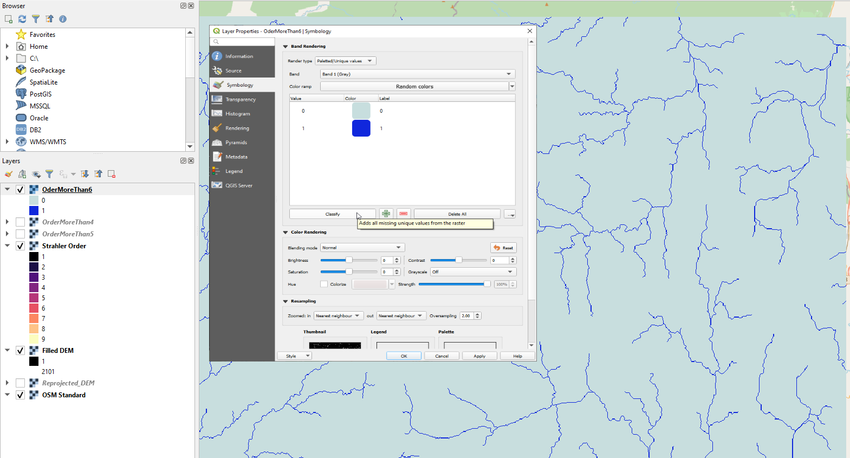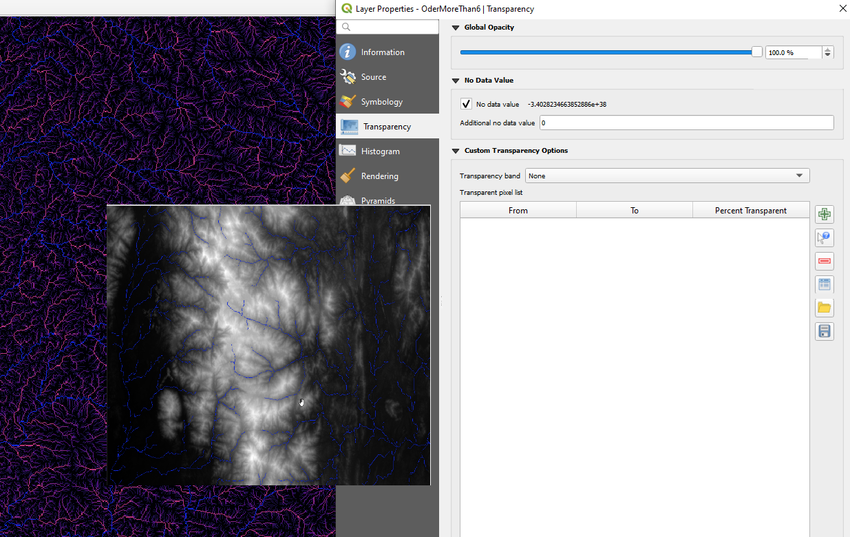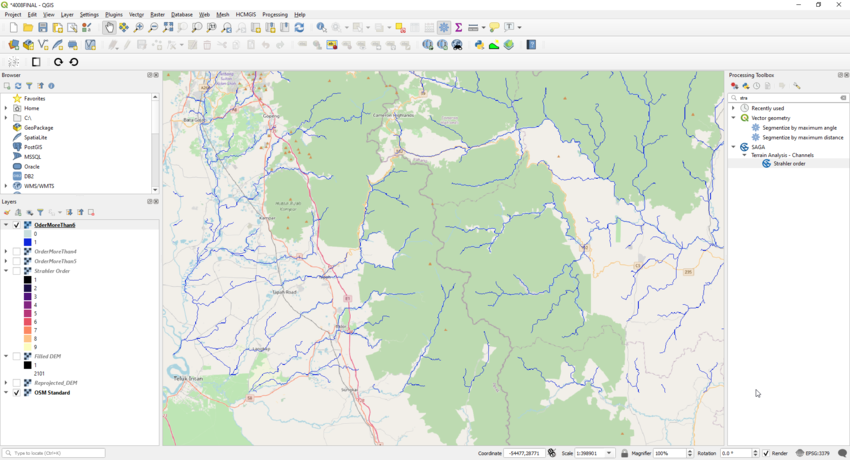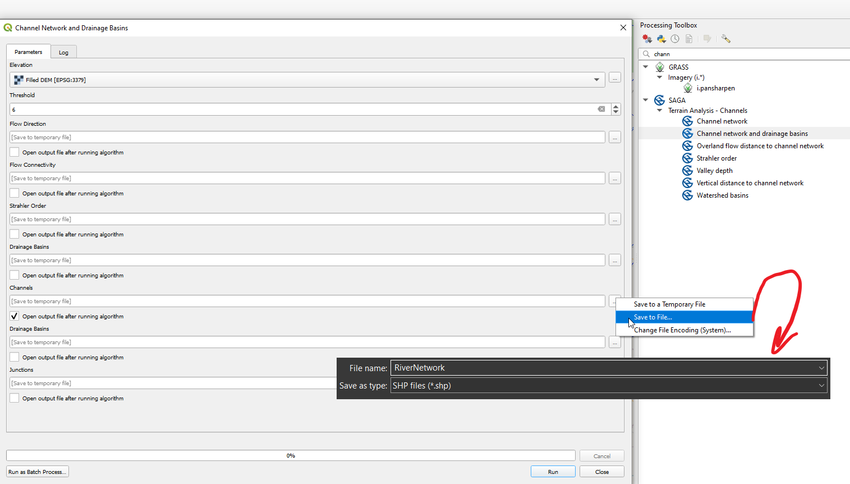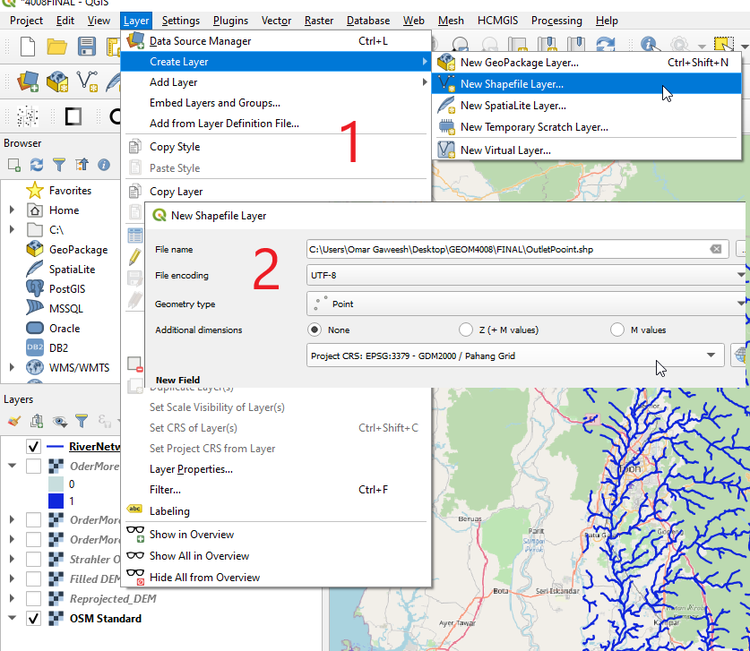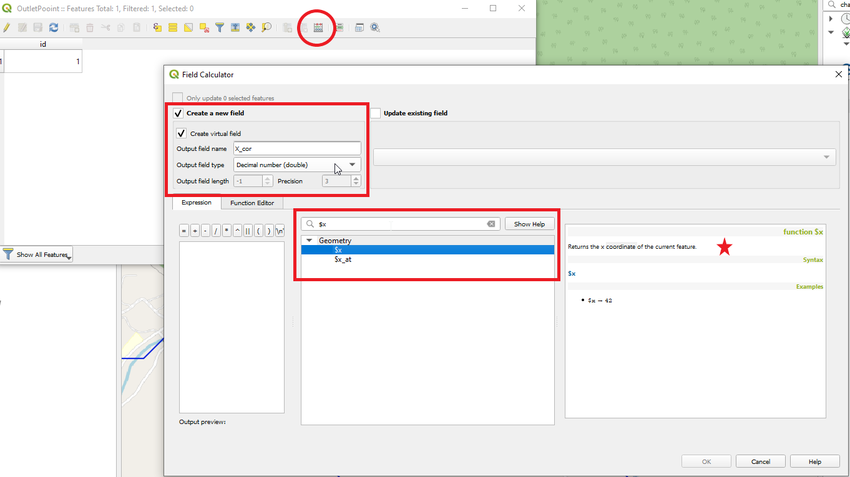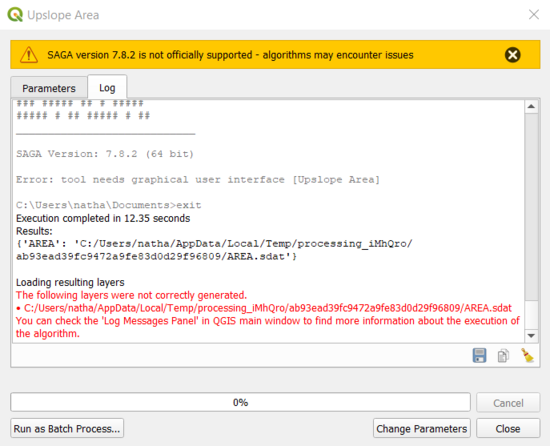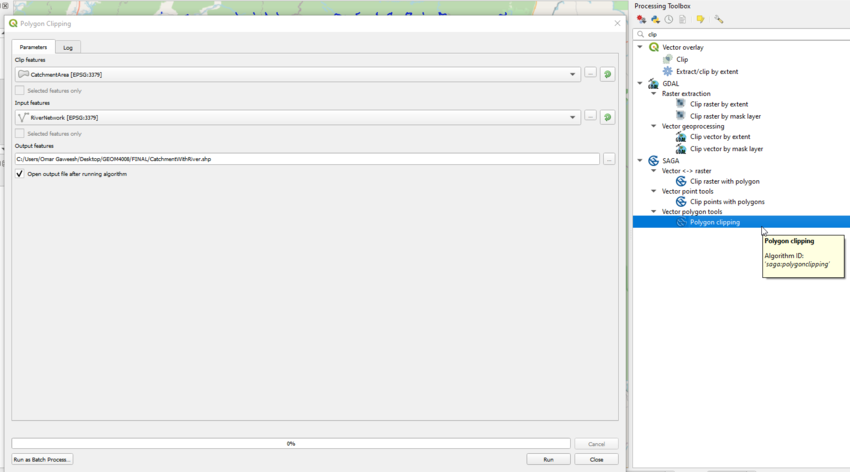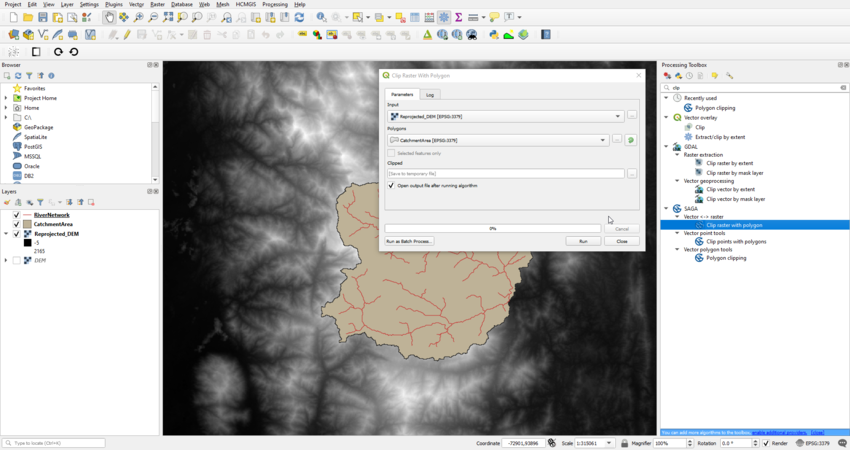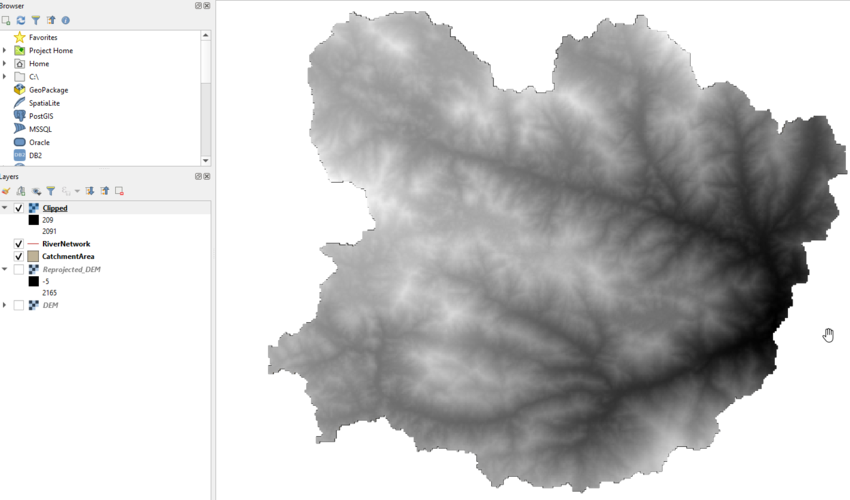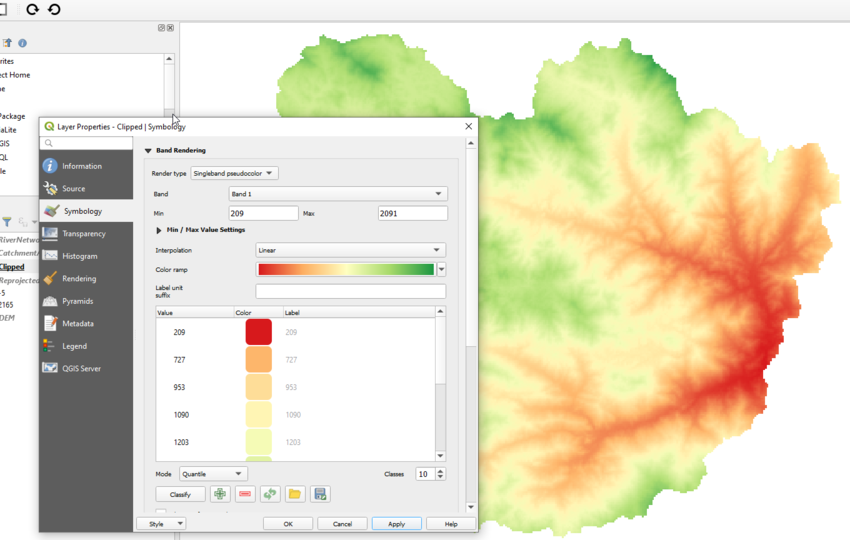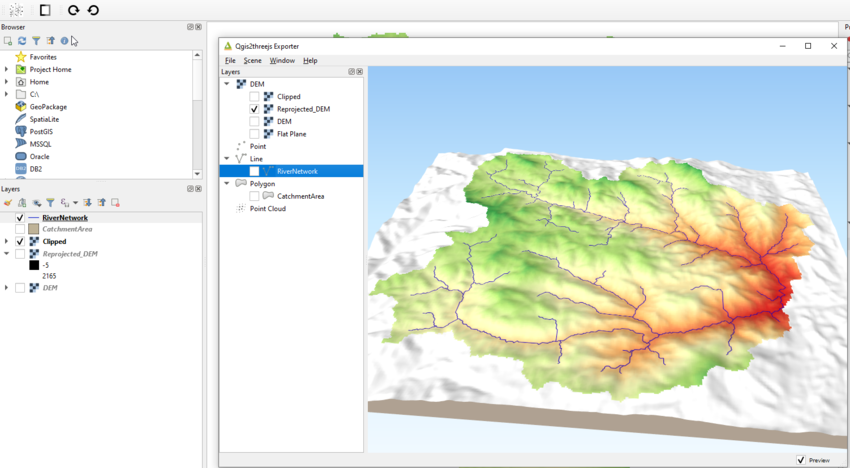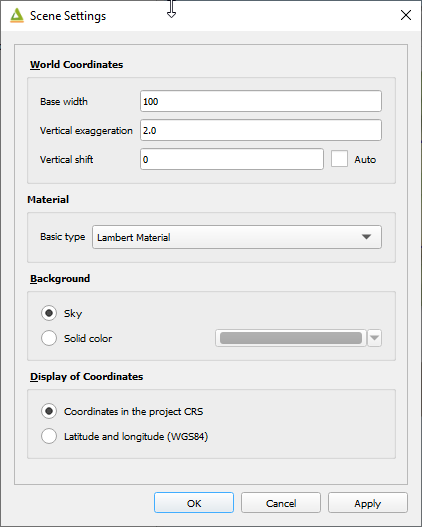Difference between revisions of "Using QGIS to conduct watershed analysis and 3D modeling"
Omargaweesh (talk | contribs) |
|||
| (31 intermediate revisions by 3 users not shown) | |||
| Line 2: | Line 2: | ||
== Introduction and purpose == |
== Introduction and purpose == |
||
| − | The purpose |
+ | The purpose of this this tutorial is to show how QGIS can be used to conduct a watershed analysis and how to create a 3D model of a catchment area using DEMs (Digital Elevation Model). This tutorial is meant to educate the user on how to conduct the analysis while introducing the theory behind it in a simple manner so that the user can understand the theory and execute tutorial at the same time. |
== Acquiring DEMs == |
== Acquiring DEMs == |
||
| − | There are many websites that allow users to acquire DEMs |
+ | There are many websites that allow users to acquire DEMs. If you are a Carleton student, the best website to use is the Geospatial Data Library of Carleton University linked [https://library.carleton.ca/find/gis/geospatial-data '''HERE''']. |
| − | Carleton University grants its student access to all sorts of geospatial data through its library and third parties like Scholars GeoPortal. For the purpose of this tutorial, I have found a DEM of rivers in Malaysia and will provide you with a link to the DEM if you would like to follow along. The link to the DEM can be downloaded from [https://drive.google.com/file/d/1L2yogYlSOxmCYV_NKfPHCSqT69lPZ0e7/view?usp=sharing '''HERE''']. |
+ | Carleton University grants its student access to all sorts of geospatial data through its library and third parties like Scholars GeoPortal, which is also available to many other university students, and parts of it are accessible by the general public. For the purpose of this tutorial, I have found a DEM of rivers in Malaysia and will provide you with a link to the DEM if you would like to follow along. The link to the DEM can be downloaded from [https://drive.google.com/file/d/1L2yogYlSOxmCYV_NKfPHCSqT69lPZ0e7/view?usp=sharing '''HERE''']. |
| + | If you do not wish to use the DEM of rivers in Malaysia, a good starting point to find DEMs is the USGS (for global DEMS) and the Government of Canada (for Canadian DEMs). Both websites are linked below: |
||
| + | USGS: https://www.usgs.gov/faqs/where-can-i-get-global-elevation-data?qt-news_science_products=0#qt-news_science_products |
||
| + | Government of Canada: https://maps.canada.ca/czs/index-en.html |
||
== Plug-ins installation == |
== Plug-ins installation == |
||
| − | To help us reference the position of our DEM when we add it to our layers tab, the plug-in '''QuickMapServices''' will help us find easy and quick basemaps. |
+ | To help us reference the position of our DEM when we add it to our layers tab, the plug-in '''QuickMapServices''' will help us find easy and quick basemaps. Alternatively the HCMGIS plug in can be installed for a wide variety of base maps. First go to the main tool bar at the top, click on ''Plugins'' then '' Manage and Install Plugins...'' |
| + | [[File:PluginsNavigation.png|850px|border|center]] |
||
| + | |||
| + | |||
[[File:QuickMap.png|850px|border|center]] |
[[File:QuickMap.png|850px|border|center]] |
||
| Line 23: | Line 29: | ||
== Adding DEM and projecting == |
== Adding DEM and projecting == |
||
| + | After downloading the DEM the first step is to add it to the QGIS project. Luckily this is very easy; simply go to the folder where the DEM is saved nd drag and drop it into the ''Layers'' pane as shown below: |
||
| + | [[File:DragandDropDEM.png|850px|border|center]] |
||
| − | Once we add our DEM.tif file to our Layers, we use QuickMapServices to add a basemap. From our drop down menus, ''Web > QuickMapServices > OSM > OSM Standard''. This will display Open Street Map in the |
+ | Once we add our DEM.tif file to our Layers, we use QuickMapServices to add a basemap. From our drop down menus, ''Web > QuickMapServices > OSM > OSM Standard''. This will display Open Street Map in the background of our DEM as shown below: |
[[File:OSM.png|850px|border|center]] |
[[File:OSM.png|850px|border|center]] |
||
| Line 30: | Line 38: | ||
| − | Next, we re-project our DEM to the appropriate projection, in our case -Malaysia- we can use GDM2000/Pahang Grid. ''Raster> Projections > Warp (Reproject) > Select GDM2000/Pahang Grid for target CRS.'' |
+ | Next, we re-project our DEM to the appropriate projection, in our case for this area in -Malaysia- we can use GDM2000/Pahang Grid. ''Raster> Projections > Warp (Reproject) > Select GDM2000/Pahang Grid for target CRS.'' If you are not using the Malaysia DEM please research which projection may be appropriate for the region of the world your DEM is from as there are many different projections and not all are created equal. |
| − | And from the bottom right hand corner, click on the projection icon, which will open the Project Properties, under CRS, chose GDM2000/Pahang Grid again. |
+ | And from the bottom right hand corner, to change the projection of the of the current map (base map), click on the projection icon, which will open the Project Properties, under CRS, chose GDM2000/Pahang Grid again. |
[[File:Target.png|850px|border|center]] |
[[File:Target.png|850px|border|center]] |
||
| − | [[File:Qgis-bin u1JtqhvlSe.png|850px|border| |
+ | [[File:Qgis-bin u1JtqhvlSe.png|850px|border|centre]] [[File:ProjectionButton.png|450px|border|centre]] |
| ⚫ | |||
| + | To rename it, right click on the reprojected layer, select export then select save as. Leave all the settings as they are and name the file "Reprojected_DEM". |
||
| + | [[File:SaveAsNav.png|420px|border|centre]] |
||
| ⚫ | |||
| + | |||
| + | |||
| + | [[File:GeoTiff.png|420px|border|centre]] |
||
| + | To remove a layer right click on the layer and select "remove layer". |
||
| + | [[File:Removelayer.png|450px|border|centre]] |
||
Now that we have our DEM ready, we can start the analysis! |
Now that we have our DEM ready, we can start the analysis! |
||
| Line 47: | Line 62: | ||
=== Step 1: Filling Sinks === |
=== Step 1: Filling Sinks === |
||
| − | The very first step |
+ | The very first step in our analysis is to do what is called Fill Sinks. The Fill Sinks tool by Wang & Liu produces a DEM free of depressions (AKA sinks) that would capture the flow of water, hence, conserving the waterflow in our data. The figure below is an example of a model with a "Sink" vs the same surface after filling the "Sink", overland flow is continuous, which can be shown on Saga GIS tutorials website.[1] |
[[File:Image072.png|250px|border|center|Sink vs Filled sink]] |
[[File:Image072.png|250px|border|center|Sink vs Filled sink]] |
||
| Line 53: | Line 68: | ||
| − | From '' |
+ | From ''Toolbox (gear icon near center top)) > SAGA > Terrain Analysis > Fill sinks (wang & liu)''. Or alternatively use the tool box search bar. Make sure to select the '''Reprojected_DEM''' and untick every option except Open output file after running algorithm for Filled DEM and save to file using the 3 doted icon next to it. Set the minimum slope to 0.01 and Hit '''RUN''' This may take a few seconds or longer depending on the specs of your machine. Once finished hit the close button. |
| Line 123: | Line 138: | ||
| − | From '' |
+ | From ''Toolbox > SAGA > Terrain Analysis-Channels > Strahler Order'' or alternatively search the tool box. Open the tool and make sure to select the '''Filled DEM''' and tic (Open output file after running algorithm) and save to file using the 3 dotted icon next to it. Hit '''RUN''' |
[[File:SO.png|850px|border|center]] |
[[File:SO.png|850px|border|center]] |
||
| Line 134: | Line 149: | ||
| − | As we can see from the image above, Strahler Order identified 9 stream orders (1 to 9 under the raster layer) and it can be noted that some |
+ | As we can see from the image above, Strahler Order identified 9 stream orders (you may see a different number of orders) (1 to 9 under the raster layer) and it can be noted that some streams are brighter than others (Higher in Order). In order to make more sense of our 9 stream orders, we can change the Symbology of our raster. From the ''layer properties > Symbology''. Change render type to Singleband pseudocolor and choose a color ramp that you like. Change Mode to Equal Interval and the number of classes to 9 as shown in the figure below: |
[[File:Qgis-bin 6B2eI1fxVp.png|850px|border|center]] |
[[File:Qgis-bin 6B2eI1fxVp.png|850px|border|center]] |
||
| − | Now we have a better view of our stream orders, where the darker ones are smaller in order and the |
+ | Now we have a better view of our stream orders, where the darker ones are smaller in order and the larger ones go up from dark purple to yellow. |
| − | Depending on the analysis, we might not want to |
+ | Depending on the analysis, for the purpose of this demonstration we might not want to include the low streams in our analysis. Since Strahler Order assigns stream orders for each stream, we can use Raster Calculator to eliminate the small streams. |
From the drop down menus, go to ''Raster > Raster Calculator'', the following menu shows up: |
From the drop down menus, go to ''Raster > Raster Calculator'', the following menu shows up: |
||
| Line 149: | Line 164: | ||
| − | From Raster Bands, select Strahler Order@1 and for the sake of our tutorial, we are interested in streams that are larger than or equal to 6. Make sure to save the result by clicking of the 3 doted icon highlighted in the image above. |
+ | From Raster Bands, select Strahler Order@1, and for the sake of our tutorial, we are interested in streams that are larger than or equal to 6. Double click on "Strahler Order@1" to add it to the expression and then type in >=6. Make sure to save the result by clicking of the 3 doted icon highlighted in the image above. |
For the sake of demonstration, I have repeated this step for streams >= 4, >=5 and >=6 with the results shown below: |
For the sake of demonstration, I have repeated this step for streams >= 4, >=5 and >=6 with the results shown below: |
||
| Line 159: | Line 174: | ||
| − | As we can see from the image above, a stream order of 6 included our main rivers and looked the |
+ | As we can see from the image above, a stream order of 6 included our main rivers and looked the least busy. We will use stream order of 6 in our analysis going forward and will be referred to as '''SO6''' (OrderMoreThan6 in the screenshots). |
We can further improve the visibility SO6 by adjusting the Symbology: layer properties > Symbology. Change render type to Platted (Unique Values), then click on classify to show our unique values. Notice that running Raster Calculation resulted in 2 unique values of 0 (not river) and 1 (River) as it combined all of the SO6 streams into 1 river/stream. |
We can further improve the visibility SO6 by adjusting the Symbology: layer properties > Symbology. Change render type to Platted (Unique Values), then click on classify to show our unique values. Notice that running Raster Calculation resulted in 2 unique values of 0 (not river) and 1 (River) as it combined all of the SO6 streams into 1 river/stream. |
||
| Line 183: | Line 198: | ||
[[File:Qgis-bin uEMSfxRC3P.png|850px|border|center]] |
[[File:Qgis-bin uEMSfxRC3P.png|850px|border|center]] |
||
| − | === Step 3 |
+ | === Step 3: Channel network === |
| − | After isolating SO6, we save our river network as a shapefile using the SAGA tool '''Channel network and Drainage basins'''. This tool can |
+ | After isolating SO6, we save our river network as a shapefile using the SAGA tool '''Channel network and Drainage basins'''. This tool can also show the Strahler Order and even the direction of the water flow. For the sake of our tutorial, we are only focused on the river network channels. |
| − | From the toolbox, search for Channel network and Drainage basins. Select Elevation to be our '''Filled DEM''' and set the threshold to 6 (The stream order), uncheck everything except Channels and save file as a Shapefile as shown below: |
+ | From the toolbox, search for Channel network and Drainage basins. ''Toolbox > Saga > Terrain Analysis-Channels > Channel Network and Drainage Basins'' Select Elevation to be our '''Filled DEM''' and set the threshold to 6 (The stream order), uncheck everything except Channels and save file as a Shapefile as shown below: |
| Line 193: | Line 208: | ||
| − | + | I named the shapefile '''RiverNetwork''' and gave it a thicker blue line in symbology as shown below: |
|
| Line 199: | Line 214: | ||
[[File:Qgis-bin 4XsIwbLsmV.png|850px|border|center]] |
[[File:Qgis-bin 4XsIwbLsmV.png|850px|border|center]] |
||
| ⚫ | |||
| ⚫ | After acquiring our shapefile '''RiverNetwork''', we can now start to create catchment areas for points of interest. A drainage basin is any area where precipitation collects and drains off into '''one outlet''', such as into a river, bay, or other body of water. The drainage basin includes all types of surface water like snowmelt, groundwater, rain runoff, and streams that run downslope towards that '''one outlet''' [5]. From the definition, we would need an '''outlet''' for us to conduct our analysis. |
||
| ⚫ | |||
| − | |||
| ⚫ | After acquiring our shapefile '''RiverNetwork''', we can now start to create catchment areas for points of interest. A drainage basin is any area where precipitation collects and drains off into '''one outlet''', such as into a river, bay, or other body of water. The drainage basin includes all types of surface water like snowmelt, groundwater, rain runoff, and streams that run downslope towards that '''one outlet''' [ |
||
1- Create a point shapefile and make sure to select the proper projection as follows: |
1- Create a point shapefile and make sure to select the proper projection as follows: |
||
| + | ''Layer > Create Layer > New Shapefile layer'' choose a name nd location to save the new layer. Geometry type will be point and make sure to select the same projection as the rest of the project under the additional dimensions heading. |
||
| − | |||
| Line 213: | Line 227: | ||
| − | Make sure to show the old DEM pixels in order to pick the right stream that you are interested in, for the sake of our tutorial, I have selected a location in the middle of the river that had a high stream order (yellow), toggle editing and add you point where desired. (Notice that River network does not align perfectly everywhere, a higher quality DEM or the use of SAR imagery would result in higher quality results) |
+ | Make sure to show the old DEM pixels in order to pick the right stream that you are interested in, for the sake of our tutorial, I have selected a location in the middle of the river that had a high stream order (yellow). Select your new point layer, toggle editing (the button that looks like a pencil), click on add point feature, and add you point where desired. Save the edits (button between the two used already). (Notice that River network does not align perfectly everywhere, a higher quality DEM or the use of SAR imagery would result in higher quality results) |
| + | [[File:ToggleEdit.png|850px|border|center]] |
||
| + | |||
[[File:Pepe.png|850px|border|center]] |
[[File:Pepe.png|850px|border|center]] |
||
| − | 2- After saving our outlet point, go to the attributes ''table > field calculator''. Make sure to add a new field, search for ($x) which returns the X coordinate of the feature. Change the output field type to Decimal number. Do the same for Y |
+ | 2- After saving our outlet point, go to the attributes ''Right click on point layer > attribute table'' ''table > field calculator''. Make sure to add a new field, search for ($x) which returns the X coordinate of the feature. Change the output field type to Decimal number. Do the same for Y, this time with $y |
| Line 227: | Line 243: | ||
| − | Result should be the X and Y coordinates as such: |
+ | Result should be the X and Y coordinates as such, your numbers will be different unless somehow you got the exact same spot: |
| Line 235: | Line 251: | ||
3- Since we now have a river network and an outlet point, we can create our catchment area by using the SAGA tool '''Upslope Area'''. |
3- Since we now have a river network and an outlet point, we can create our catchment area by using the SAGA tool '''Upslope Area'''. |
||
| + | '''Upslope Area''' allows users to specify target cells (in a lower elevation), for which the upslope contributing areas (higher elevation) shall be identified [6]. This tool -in a way- allows us to tilt up around a point with X and Y coordinates and see what would fall into it. |
||
| ⚫ | |||
| + | |||
| + | |||
| ⚫ | From the toolbox, search for '''Upslope Area''', when the menu dialogue pops up, copy/paste in the target X and Y coordinates from the attribute table of our '''outlet point''' and choose the '''Filled DEM''' as our elevation as shown in the image below; and set the method to Deterministic[8]. Click run and close the dialoged box once finished. |
||
[[File:Qgis-bin zdazCXsaY3.png|850px|border|center]] |
[[File:Qgis-bin zdazCXsaY3.png|850px|border|center]] |
||
| + | |||
| + | '''WARNING''' at this point you may encounter an error that looks like this. |
||
| + | |||
| + | [[File:Errorpic.png|550px|border|center]]] |
||
| + | |||
| + | The reason why the tool failed is because your version of QGIS does not support SAGA. The Easierst work around is to simply install the QGIS version under the heading '''Long-term release in old OSGeo4W (continued with previous dependencies)'''. This makes sure that none of the older SAGA tools are broken |
||
| + | |||
| + | [[File:Heading.png|550px|border|center]] |
||
| + | |||
| + | |||
| + | The second option is to edit the saga program file. This is more complicated and untested by the editor as of 2021 but this video described the process well https://www.youtube.com/watch?v=t-2ExoyhIfA and even if you do want to try this method it may still not work as you need administrator permissions on your machine. |
||
| − | The following is the result of the Upslope analysis, you can see the outlet point in red, the '''RiverNetwork''' in blue and most importantly, the catchment area in white |
+ | The following is the result of the Upslope analysis, you can see the outlet point in red, the '''RiverNetwork''' in blue and most importantly, the catchment area in white. If it is not visible it is possible that it is being covered by other layers, layers can be reordered by clicking and dragging. Layers further up the list are on top layers further down are underneath. |
| Line 266: | Line 296: | ||
| − | 6- Clip the resulting shapefile with the '''RiverNetwork''' using the SAGA tool Polygon clipping as shown below: |
+ | 6- Clip the resulting shapefile with the '''RiverNetwork''' using the SAGA tool Polygon clipping as shown below: ''Toolbox > Saga > Vector Polygon Tools > Polygon Clipping'' |
| Line 273: | Line 303: | ||
| + | This can be saved as a separate file and once saved the original river network file can be removed. |
||
| − | |||
| Line 299: | Line 329: | ||
| − | 1- Using the '''Reprojected_DEM''' , the catchment area shapefile and the '''RiverNetwork''' we just created, we clip DEM raster to our catchment area shapefile using the SAGA tool Clip |
+ | 1- Using the '''Reprojected_DEM''' , the catchment area shapefile and the '''RiverNetwork''' we just created, we clip DEM raster to our catchment area shapefile using the SAGA tool '''Clip raster with polygon''' as shown in the image below: |
| − | raster with polygon as shown in the image below: |
||
| Line 342: | Line 371: | ||
| − | As we can see, '''Qgis2threejs''' created a 3D model of our DEM, but to further improve the 3D model, we can increase the Vertical Exaggeration from the default 1.0 to 2.0 or more as you see fit: |
+ | As we can see, '''Qgis2threejs''' created a 3D model of our DEM, but to further improve the 3D model, we can increase the Vertical Exaggeration from the default 1.0 to 2.0 or more as you see fit: ''Scene > Scene Setting '' |
| Line 357: | Line 386: | ||
| + | If you wish to save your 3D model go to ''File > Save as'' and choose your format. |
||
Now we can easily understand how how watershed analysis works! streams with lower order in areas with higher elevation (Green) merge together forming higher order streams that flow down the slopes of higher elevations until we get to areas with lower elevations (Yellow to Red) where in our case, the streams on the right and the streams on the left merge together in our Outlet area (red). |
Now we can easily understand how how watershed analysis works! streams with lower order in areas with higher elevation (Green) merge together forming higher order streams that flow down the slopes of higher elevations until we get to areas with lower elevations (Yellow to Red) where in our case, the streams on the right and the streams on the left merge together in our Outlet area (red). |
||
| − | |||
== References == |
== References == |
||
| Line 372: | Line 401: | ||
| + | [4] "Stream order", En.wikipedia.org, 2020. [Online]. Available: https://en.wikipedia.org/wiki/Stream_order. |
||
| ⚫ | |||
| + | |||
| + | |||
| ⚫ | |||
| + | |||
| + | |||
| + | [6] "Tool Upslope Area / SAGA-GIS Tool Library Documentation (v7.1.1)", Saga-gis.org, 2020. [Online]. Available: http://www.saga-gis.org/saga_tool_doc/7.1.1/ta_hydrology_4.html. |
||
Latest revision as of 23:53, 1 October 2021
Contents
Introduction and purpose
The purpose of this this tutorial is to show how QGIS can be used to conduct a watershed analysis and how to create a 3D model of a catchment area using DEMs (Digital Elevation Model). This tutorial is meant to educate the user on how to conduct the analysis while introducing the theory behind it in a simple manner so that the user can understand the theory and execute tutorial at the same time.
Acquiring DEMs
There are many websites that allow users to acquire DEMs. If you are a Carleton student, the best website to use is the Geospatial Data Library of Carleton University linked HERE. Carleton University grants its student access to all sorts of geospatial data through its library and third parties like Scholars GeoPortal, which is also available to many other university students, and parts of it are accessible by the general public. For the purpose of this tutorial, I have found a DEM of rivers in Malaysia and will provide you with a link to the DEM if you would like to follow along. The link to the DEM can be downloaded from HERE. If you do not wish to use the DEM of rivers in Malaysia, a good starting point to find DEMs is the USGS (for global DEMS) and the Government of Canada (for Canadian DEMs). Both websites are linked below:
USGS: https://www.usgs.gov/faqs/where-can-i-get-global-elevation-data?qt-news_science_products=0#qt-news_science_products Government of Canada: https://maps.canada.ca/czs/index-en.html
Plug-ins installation
To help us reference the position of our DEM when we add it to our layers tab, the plug-in QuickMapServices will help us find easy and quick basemaps. Alternatively the HCMGIS plug in can be installed for a wide variety of base maps. First go to the main tool bar at the top, click on Plugins then Manage and Install Plugins...
And to help us with 3D modeling, we will install the plug-in Qgis2threejs, which will use the elevation values in our DEM to create a 3D model of our catchment area.
Adding DEM and projecting
After downloading the DEM the first step is to add it to the QGIS project. Luckily this is very easy; simply go to the folder where the DEM is saved nd drag and drop it into the Layers pane as shown below:
Once we add our DEM.tif file to our Layers, we use QuickMapServices to add a basemap. From our drop down menus, Web > QuickMapServices > OSM > OSM Standard. This will display Open Street Map in the background of our DEM as shown below:
Next, we re-project our DEM to the appropriate projection, in our case for this area in -Malaysia- we can use GDM2000/Pahang Grid. Raster> Projections > Warp (Reproject) > Select GDM2000/Pahang Grid for target CRS. If you are not using the Malaysia DEM please research which projection may be appropriate for the region of the world your DEM is from as there are many different projections and not all are created equal. And from the bottom right hand corner, to change the projection of the of the current map (base map), click on the projection icon, which will open the Project Properties, under CRS, chose GDM2000/Pahang Grid again.
After we are done with projections, the old DEM layer can be removed and we can rename the reprojected layer; for the sake of simplicity, it will be renamed Reprojected_DEM. To rename it, right click on the reprojected layer, select export then select save as. Leave all the settings as they are and name the file "Reprojected_DEM".
To remove a layer right click on the layer and select "remove layer".
Now that we have our DEM ready, we can start the analysis!
Watershed Analysis
Step 1: Filling Sinks
The very first step in our analysis is to do what is called Fill Sinks. The Fill Sinks tool by Wang & Liu produces a DEM free of depressions (AKA sinks) that would capture the flow of water, hence, conserving the waterflow in our data. The figure below is an example of a model with a "Sink" vs the same surface after filling the "Sink", overland flow is continuous, which can be shown on Saga GIS tutorials website.[1]
From Toolbox (gear icon near center top)) > SAGA > Terrain Analysis > Fill sinks (wang & liu). Or alternatively use the tool box search bar. Make sure to select the Reprojected_DEM and untick every option except Open output file after running algorithm for Filled DEM and save to file using the 3 doted icon next to it. Set the minimum slope to 0.01 and Hit RUN This may take a few seconds or longer depending on the specs of your machine. Once finished hit the close button.
Notice the difference in our min and max values between the Filled DEM and our Reprojected_DEM:
Step 2: Strahler Order
According to the system made by Strahler [2] [3], rivers of the first order are the outermost tributaries. If two streams of the same order meet, the resulting stream is given a number that is one higher. If two rivers of different stream orders meet, the resulting stream gets the higher of the two numbers. The following diagram showcases how Strahler Order works:
From Toolbox > SAGA > Terrain Analysis-Channels > Strahler Order or alternatively search the tool box. Open the tool and make sure to select the Filled DEM and tic (Open output file after running algorithm) and save to file using the 3 dotted icon next to it. Hit RUN
The resulting raster looks like this:
As we can see from the image above, Strahler Order identified 9 stream orders (you may see a different number of orders) (1 to 9 under the raster layer) and it can be noted that some streams are brighter than others (Higher in Order). In order to make more sense of our 9 stream orders, we can change the Symbology of our raster. From the layer properties > Symbology. Change render type to Singleband pseudocolor and choose a color ramp that you like. Change Mode to Equal Interval and the number of classes to 9 as shown in the figure below:
Now we have a better view of our stream orders, where the darker ones are smaller in order and the larger ones go up from dark purple to yellow.
Depending on the analysis, for the purpose of this demonstration we might not want to include the low streams in our analysis. Since Strahler Order assigns stream orders for each stream, we can use Raster Calculator to eliminate the small streams.
From the drop down menus, go to Raster > Raster Calculator, the following menu shows up:
From Raster Bands, select Strahler Order@1, and for the sake of our tutorial, we are interested in streams that are larger than or equal to 6. Double click on "Strahler Order@1" to add it to the expression and then type in >=6. Make sure to save the result by clicking of the 3 doted icon highlighted in the image above.
For the sake of demonstration, I have repeated this step for streams >= 4, >=5 and >=6 with the results shown below:
As we can see from the image above, a stream order of 6 included our main rivers and looked the least busy. We will use stream order of 6 in our analysis going forward and will be referred to as SO6 (OrderMoreThan6 in the screenshots).
We can further improve the visibility SO6 by adjusting the Symbology: layer properties > Symbology. Change render type to Platted (Unique Values), then click on classify to show our unique values. Notice that running Raster Calculation resulted in 2 unique values of 0 (not river) and 1 (River) as it combined all of the SO6 streams into 1 river/stream.
To make the most out of our SO6 symbology, we can make the Non-river pixels transparent by going to layer properties > Transparency > Additional no data value : 0 > Apply/Ok. That results in the non-river pixels being fully transparent and we can clearly see our SO6 highlighted in blue over our old DEM for reference as shown below:
Here is an image of SO6 over the basemap:
Step 3: Channel network
After isolating SO6, we save our river network as a shapefile using the SAGA tool Channel network and Drainage basins. This tool can also show the Strahler Order and even the direction of the water flow. For the sake of our tutorial, we are only focused on the river network channels.
From the toolbox, search for Channel network and Drainage basins. Toolbox > Saga > Terrain Analysis-Channels > Channel Network and Drainage Basins Select Elevation to be our Filled DEM and set the threshold to 6 (The stream order), uncheck everything except Channels and save file as a Shapefile as shown below:
I named the shapefile RiverNetwork and gave it a thicker blue line in symbology as shown below:
Step 4: Catchment areas / Drainage basins
After acquiring our shapefile RiverNetwork, we can now start to create catchment areas for points of interest. A drainage basin is any area where precipitation collects and drains off into one outlet, such as into a river, bay, or other body of water. The drainage basin includes all types of surface water like snowmelt, groundwater, rain runoff, and streams that run downslope towards that one outlet [5]. From the definition, we would need an outlet for us to conduct our analysis.
1- Create a point shapefile and make sure to select the proper projection as follows: Layer > Create Layer > New Shapefile layer choose a name nd location to save the new layer. Geometry type will be point and make sure to select the same projection as the rest of the project under the additional dimensions heading.
Make sure to show the old DEM pixels in order to pick the right stream that you are interested in, for the sake of our tutorial, I have selected a location in the middle of the river that had a high stream order (yellow). Select your new point layer, toggle editing (the button that looks like a pencil), click on add point feature, and add you point where desired. Save the edits (button between the two used already). (Notice that River network does not align perfectly everywhere, a higher quality DEM or the use of SAR imagery would result in higher quality results)
2- After saving our outlet point, go to the attributes Right click on point layer > attribute table table > field calculator. Make sure to add a new field, search for ($x) which returns the X coordinate of the feature. Change the output field type to Decimal number. Do the same for Y, this time with $y
Result should be the X and Y coordinates as such, your numbers will be different unless somehow you got the exact same spot:
3- Since we now have a river network and an outlet point, we can create our catchment area by using the SAGA tool Upslope Area.
Upslope Area allows users to specify target cells (in a lower elevation), for which the upslope contributing areas (higher elevation) shall be identified [6]. This tool -in a way- allows us to tilt up around a point with X and Y coordinates and see what would fall into it.
From the toolbox, search for Upslope Area, when the menu dialogue pops up, copy/paste in the target X and Y coordinates from the attribute table of our outlet point and choose the Filled DEM as our elevation as shown in the image below; and set the method to Deterministic[8]. Click run and close the dialoged box once finished.
WARNING at this point you may encounter an error that looks like this.
]
The reason why the tool failed is because your version of QGIS does not support SAGA. The Easierst work around is to simply install the QGIS version under the heading Long-term release in old OSGeo4W (continued with previous dependencies). This makes sure that none of the older SAGA tools are broken
The second option is to edit the saga program file. This is more complicated and untested by the editor as of 2021 but this video described the process well https://www.youtube.com/watch?v=t-2ExoyhIfA and even if you do want to try this method it may still not work as you need administrator permissions on your machine.
The following is the result of the Upslope analysis, you can see the outlet point in red, the RiverNetwork in blue and most importantly, the catchment area in white. If it is not visible it is possible that it is being covered by other layers, layers can be reordered by clicking and dragging. Layers further up the list are on top layers further down are underneath.
4- Since our result is still a raster, we can turn it into a polygon by going to the drop menu Raster > Conversion > Polygonize (Raster to Vector). Input layer should be the Upslope Area and the file should be saved as a shapefile.
5- Add the shapefile that you just saved to your layers, them from attributes table, select the area outside your catchment area and hit delete (Note, you can delete the vectorized layer that is added by default).
6- Clip the resulting shapefile with the RiverNetwork using the SAGA tool Polygon clipping as shown below: Toolbox > Saga > Vector Polygon Tools > Polygon Clipping
This can be saved as a separate file and once saved the original river network file can be removed.
Activate the layer RiverNetwork over the catchment area to see the final results.
With that done, we have successfully created a catchment area, where all those river streams pour into that outlet that we have selected! But what if we wanted to visualize that better, in 3D?
This is where 3D modeling comes into play!
3D Modeling of a DEM
1- Using the Reprojected_DEM , the catchment area shapefile and the RiverNetwork we just created, we clip DEM raster to our catchment area shapefile using the SAGA tool Clip raster with polygon as shown in the image below:
The clipped DEM looks like this:
2- We can change the symbology of the DEM by introducing a color ramp to reflect the change in elevation. Set render type to Singleband pseudocolor and Mode to Quantile, chose an appropriate number of classes (example: 10), the result would be similar to the image below:
3- Time to 3D model!
Using the plug-in tool Qgis2threejs that can be accessed through Web > Qgis2threejs > Qgis2threejs Exporter
Once activated, the Qgis2threejs Exporter window looks like this:
As we can see, Qgis2threejs created a 3D model of our DEM, but to further improve the 3D model, we can increase the Vertical Exaggeration from the default 1.0 to 2.0 or more as you see fit: Scene > Scene Setting
From our Layers, we can activate RiverNetwork to be able to view the final resulting 3D model, which looks like this:
If you wish to save your 3D model go to File > Save as and choose your format.
Now we can easily understand how how watershed analysis works! streams with lower order in areas with higher elevation (Green) merge together forming higher order streams that flow down the slopes of higher elevations until we get to areas with lower elevations (Yellow to Red) where in our case, the streams on the right and the streams on the left merge together in our Outlet area (red).
References
[1] "Preprocessing and catchment deliniation", Saga GIS tutorials, 2020. [Online]. Available: https://sagatutorials.wordpress.com/preprocessing-and-catchment-deliniation/.
[2] Strahler, A.N. Quantitative analysis of watershed geomorphology. Transactions of the American Geophysical Union. 1957; 38(6), pp. 913-920.
[3] Strahler, A.N. "Quantitative geomorphology of drainage basins and channel networks." Chow, V.T., Editor. Handbook of Applied Hydrology. New York: McGraw-Hill; 1964; pp. 4-39, 4-76
[4] "Stream order", En.wikipedia.org, 2020. [Online]. Available: https://en.wikipedia.org/wiki/Stream_order.
[5] DeBarry, Paul A. (2004). Watersheds: Processes, Assessment and Management. John Wiley & Sons.
[6] "Tool Upslope Area / SAGA-GIS Tool Library Documentation (v7.1.1)", Saga-gis.org, 2020. [Online]. Available: http://www.saga-gis.org/saga_tool_doc/7.1.1/ta_hydrology_4.html.

